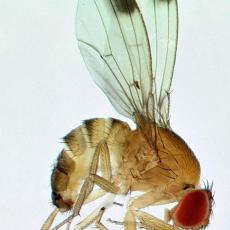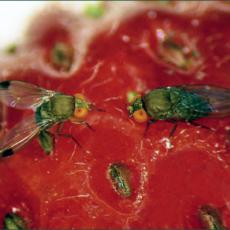Spotted Wing Drosophila ID and Biology
Identification/Lifecycle
- Overwinter as adults and maybe pupae in leaf litter, duff, and rotting fruit
- Adult flies live for up to 2 weeks
- Females can lay 300 eggs
- Can develop from egg to adult in as little as 8 days
- Likely to have over 10 generations per growing season
Damage:
- Females lay eggs in fruit
- Larvae eat flesh, which renders it unmarketable or causes customer discontent (infested fruit ‘melts down’ in 2 days)
- Egg laying introduces fungal pathogens, which rot fruit
- See more examples of damage at The Univ. of Wisconsin - SWD in Wisconsin and Recognize Fruit Damage from SWD (OSU)
Crops at Risk:
This insect has a wide host range but is primarily a pest of berry crops and some stone fruits (cherry, nectarine, peach), but may also be found in high tunnel tomatoes.
| Cultivated Host | Cultivated Host | Wild Host |
|---|---|---|
| Apple | Gooseberries | American Pokeweed |
| Asian Pear | Grapes | Autumn Olive |
| Asian Plum | Mulberries | Beach Plum |
| Blackberries | Nectarines | Climbing Nightshade |
| Blueberries | Peaches | Crabapple |
| Boysenberries | Persimmons | Elderberry |
| Cherries | Plums & Plumcots | Fox Grape |
| Cold Hardy Kiwi | Raspberries | Japanese Yew |
| Currants | Strawberries | Kousa Dogwood |
| Elderberries | Tomatoes | Porcilainberry |
| Wild Rose |
Plants in highlighted letters represent preferred hosts
Significance:
- Unlike other fruit flies, SWD attacks sound ripening fruit
- Once eggs laid in fruit, no longer able to control with pesticides
- Short lifecycle and overlapping generations make spray timing difficult
- Requires sprays near harvest time
- Requires multiple sprays which can lead to pesticide resistance
For more resources on SWD identification see the following links:
- Northeast IPM SWD Fact Sheet
- Michigan State University SWD Fact Sheet
- Penn State University SWD Fact Sheets: Overview and Identification and Natural History
- Cornell SWD website
- Ohio State SWD Fact Sheet
- University of Maine SWD ID Video



